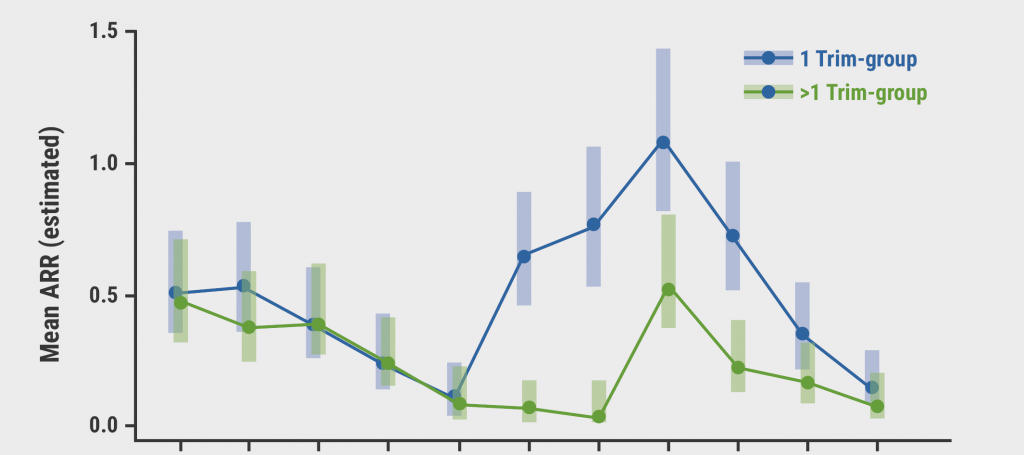In the original, phase 3 OPERA I/II (NCT01247324; NCT01412333) and ORATORIO (NCT01194570) trials, the efficacy and safety of ocrelizumab versus interferon beta-1a (IFN) in RMS and versus placebo in PPMS were demonstrated [2]. In the open-label extension (OLE) period of these studies, the effect of switching to/maintaining ocrelizumab therapy on various MRI measures was assessed. Scans were acquired at the 6th and 5th year of follow-up after starting the OLE for RMS and PPMS, respectively. Interim results of 3 years after OLE have already been published [3].
RMS patients receiving continuous ocrelizumab, compared with those who switched to ocrelizumab later, showed no differences in number of T1 gadolinium (Gd)-enhancing and new or enlarging T2 lesions (P=0.617 and P=0.760, respectively), but showed less brain structure volume loss, and significant/nominal differences in lesion volume accumulation. Percentage reduction at the 6th year of ocrelizumab-ocrelizumab versus IFN-ocrelizumab were:
- whole brain volume (WB): -6.9%, P=0.070;
- cortical grey matter volume (CGM): -6.2%, P=0.047;
- white matter volume (WM): -8.3%, P=0.240;
- thalamus volume (THAL): -21.3%, P<0.001;
- cerebellum volume (CBL): -11.0%, P=0.203;
- T2 lesion volume: -92.3%, P=0.034;
- T1 lesion volume: -11.5%, P=0.502.
PPMS patients initially randomised to ocrelizumab showed no difference in T1 Gd-enhancing lesions, a small difference in new or enlarging T2 lesions (ocrelizumab-ocrelizumab versus placebo-ocrelizumab rate: 0.010 and 0.069; P=0.0145), significant/numerical differences in brain volume loss and lesion volume accumulation. Percentage reduction at the 5th year of ocrelizumab-ocrelizumab versus placebo-ocrelizumab were:
- WB: -4.9%, P=0.388;
- CGM: -0.3%, P=0.948;
- WM: -3.1%, P=0.741;
- THAL (4th year): -17.0%, P=0.012;
- CBL (4th year): -15.7%, P=0.070;
- T2 lesion volume: -70.0%, P<0.001;
- T1 lesion volume: -28.1%, P=0.022.
Switching to/maintaining ocrelizumab therapy showed an almost complete suppression of focal MRI disease activity. Additionally, for both RMS and PPMS patients, reduction of T2 and T1 lesion volume accumulation as well as global/regional volume loss tended to persist.
- Arnold DL. Long-term suppression of MRI disease activity and reduction of global/regional volume loss: results from OPERA I/II and ORATORIO open-label extension. P407, ECTRIMS 2021 Virtual Congress, 13–15 October.
- Hauser SL, et al. N Engl J Med 2017;376(3):221–234.
- Hauser SL, et al. Neurology. 2020;95(13):e1854–e1867.
Copyright ©2021 Medicom Medical Publishers
Posted on
Previous Article
« Stopping DMT: when or if at all? Next Article
Dynamic scoring system aids decision to switch MS therapies early »
« Stopping DMT: when or if at all? Next Article
Dynamic scoring system aids decision to switch MS therapies early »
Table of Contents: ECTRIMS 2021
Featured articles
Preliminary data shows positive results of ATA188 for progressive MS
COVID-19
MS patients at risk of hampered immune response after vaccination
Immunotherapy in MS does not influence COVID-19 severity and mortality
Anti-CD20 antibodies associated with worse COVID-19 outcomes
ECTRIMS-EAN consensus on vaccination in MS patients
Experimental Treatments
The role of astrocyte phenotypes in acute MS lesions
Promising results of intrathecal MSC-NTF cells in progressive MS
Preliminary data shows positive results of ATA188 for progressive MS
Evobrutinib reduces relapses and MRI lesion activity
Primary endpoint of opicinumab for relapsing MS not met in AFFINITY trial
Elezanumab did not outperform placebo in progressive and relapsing MS
Ibudilast reduced retinal atrophy in primary progressive MS
Treatment Trials and Strategies
ECTRIMS/EAN Clinical Guidelines on MS treatment: an update
Rituximab most effective initial MS therapy in Swedish real-world study
Ublituximab meets primary endpoint for relapsing MS
Dynamic scoring system aids decision to switch MS therapies early
Long-term suppression of MRI disease activity with ocrelizumab
Stopping DMT: when or if at all?
Biomarkers
Early predictors of disability progression in paediatric-onset MS
High-sensitive biomarker detection in MS via novel ELISA assay
Cortical lesions predict cognitive impairment 20 years after MS diagnosis
Applicability of sNfL measurement in clinical practice
MRI more sensitive for disease activity than relapses in SPMS
Imaging
Changes in GABA-receptor binding among cognitively impaired MS patients
T2 lesions independently predict early conversion to SPMS
Natural killer-like CD8+ T cells as a reservoir of clonal cells related to MS activity
Neuromyelitis Optica Spectrum Disorder (NMOSD)
Eculizumab, satralizumab, or inebilizumab for NMOSD?
Long-term efficacy of satralizumab for NMOSD
Long-term efficacy data: inebilizumab for NMOSD
Progressive MS
Charcot Award 2021: Progressive MS, a personal perspective
Top score poster: Meta-analysis on the effect of DMTs
Cortical lesions predict disease progression and disability accumulation
Ocrelizumab shows long-term benefits in primary progressive MS
Other
WNT9B-gene variant associated with doubled relapse risk in MS
Melatonin associated with improved sleep quality in MS patients
“Expanded Disability Status Scale 0 is not normal”
Personality trait alterations in MS patients
Related Articles
July 30, 2019
McDonald Criteria MS often misapplied and misunderstood
December 15, 2022
REMIND-MS trial: initial results

December 20, 2022
MS activity and pregnancy outcomes after long-term use of natalizumab
© 2024 Medicom Medical Publishers. All rights reserved. Terms and Conditions | Privacy Policy
HEAD OFFICE
Laarderhoogtweg 25
1101 EB Amsterdam
The Netherlands
T: +31 85 4012 560
E: publishers@medicom-publishers.com

